I had dreams of guest posting on the great Middlebury Trailrunner, inspired by his post on Snake Mountain (the wildflower in his post is a Hepatica, by the way) . I was going to go for a run up the back side of Snake Mountain, the side where our house is located, taking pictures the whole way of plant life.
Well, I’m not that much of a runner. My reason for running is simply running away from middle age, and besides, the plant life is too distracting, and I’m not sure I want to share the less popular trail up Snake Mountain with everyone. So, the run I was thinking about turned into a much needed and great hike with Nancy and Molly the stillhyperpuppyeventhoughshe’salmostayearold. While not on campus, I still feel like I should share what we saw, though, as this is one of my favorite times of year in the plant world, the quick flash in the pan of the spring ephemerals.
Spring Ephemerals are plants that complete an entire life cycle early in the spring, before the upper tree canopy leafs out. An unknown Wikipedia author writes about “excess light” in the early spring, but after a long Vermont winter we know better. Light can be held in dearth, but the glorious spring rays are to be cherished, not called out as vain and excessive. Imagine the evolutionary trick-sprouting, flowering, reproducing, and storing of energy for the next year all within the light and cold of early spring. What a strategy.
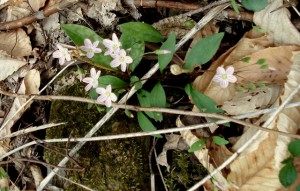 This is Spring Beauty, Claytonia virginica -an apt way to start some pictures. Grows from an underground tuber like a potato, and was used as a food source by native Americans and early settlers.
This is Spring Beauty, Claytonia virginica -an apt way to start some pictures. Grows from an underground tuber like a potato, and was used as a food source by native Americans and early settlers.
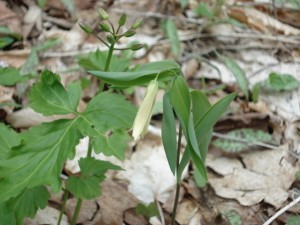 Wild Oats, or Sessile-leaved Bellwort, Uvularia sessilifolia . A common bellwort, and maybe not technically ephemeral, but pretty nonetheless.
Wild Oats, or Sessile-leaved Bellwort, Uvularia sessilifolia . A common bellwort, and maybe not technically ephemeral, but pretty nonetheless.
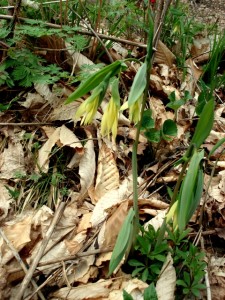 Another Bellwort, the Large Flowered, Uvularia grandiflora .
Another Bellwort, the Large Flowered, Uvularia grandiflora .
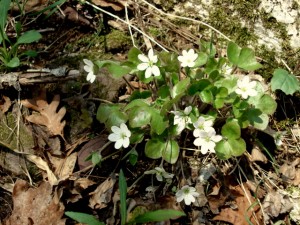 Hepatica, Hepatica americana , named for the supposed resemblance of the leaves to the shape of the liver. Can be seen in blue, white, or pink flowers.
Hepatica, Hepatica americana , named for the supposed resemblance of the leaves to the shape of the liver. Can be seen in blue, white, or pink flowers.
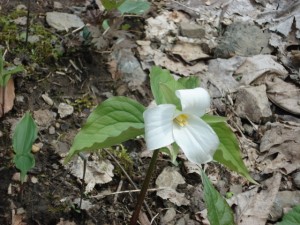 One of the grand queens in the spring ephemeral world, the Large Flowered Trillium, Trillium grandiflorum .
One of the grand queens in the spring ephemeral world, the Large Flowered Trillium, Trillium grandiflorum .
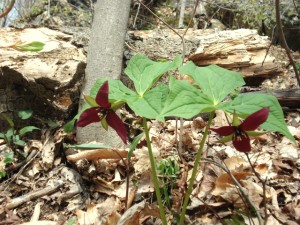
Personal favorite here, Wake Robin, or Purple Trillium, Trillium erectum. Probably the most common trillium in the northeast, and known for it’s foul scent, which it uses to attract carrion flies for pollination. The smell is such that early herbalists used the plant to treat gangrene, since plants were used to cure the ailments they resembled.
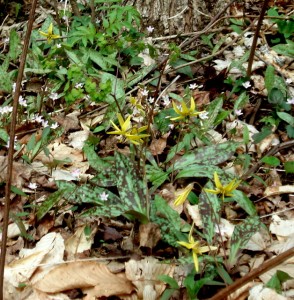 Trout Lily, Erythronium americanum. Very common in the woods lately, and named for the leaf pattern resembling the fish.
Trout Lily, Erythronium americanum. Very common in the woods lately, and named for the leaf pattern resembling the fish.
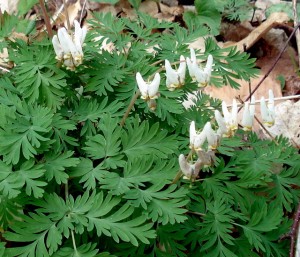 Dutchman’s Breeches (best name ever), Dicentra cucullaria. Perennial gardeners will quickly see the resemblance to Bleeding Heart, another Dicentra. Flowers are pollinated by early bumblebees, as honeybees don’t have a long enough proboscis to gather nectar.
Dutchman’s Breeches (best name ever), Dicentra cucullaria. Perennial gardeners will quickly see the resemblance to Bleeding Heart, another Dicentra. Flowers are pollinated by early bumblebees, as honeybees don’t have a long enough proboscis to gather nectar.
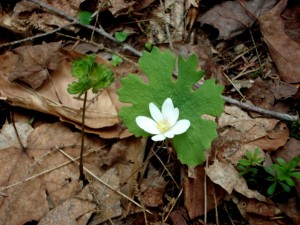 Bloodroot, Sanguinaria canadensis. So early blooming, the flowers are self pollinating, just to be on the safe side. The name comes from a dye that can be made from the roots, and was probably the ink used for the Scarlet “A” on the forehead of adulterers. There are some great patches of this in Ridgeline. The plant is myrmecochorous, ant-dependent, as it’s seeds attract the insect which then moves them around and buries them.
Bloodroot, Sanguinaria canadensis. So early blooming, the flowers are self pollinating, just to be on the safe side. The name comes from a dye that can be made from the roots, and was probably the ink used for the Scarlet “A” on the forehead of adulterers. There are some great patches of this in Ridgeline. The plant is myrmecochorous, ant-dependent, as it’s seeds attract the insect which then moves them around and buries them.
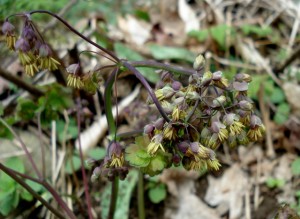 Early Meadow Rue, Thalictrum dioicum.
Early Meadow Rue, Thalictrum dioicum.
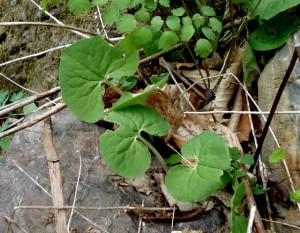 Some Wild Ginger I found in a tree stump, Asarum canadense. Strange and kinda ugly brown flowers thankfully hidden beneath the foliage-ant pollinated.
Some Wild Ginger I found in a tree stump, Asarum canadense. Strange and kinda ugly brown flowers thankfully hidden beneath the foliage-ant pollinated.
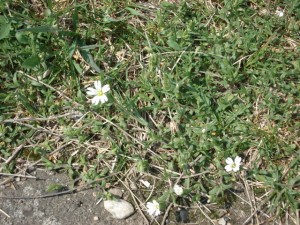
Mouse Ear Chickweed, Cerastium vulgatum. This was on the top of the mountain by the concrete platform, which makes sense seeing as it is an escaped European plant. Now a lawn weed, but reportedly edible leaves once boiled like other greens.
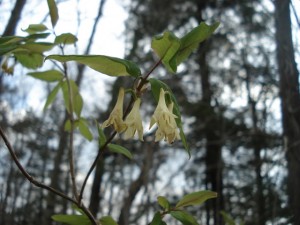 American Fly Honeysuckle, Lonicera canadensis. Not an ephemeral, but a woody plant along the trail edge.
American Fly Honeysuckle, Lonicera canadensis. Not an ephemeral, but a woody plant along the trail edge.
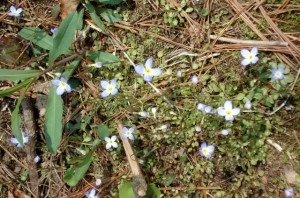 Bluets, Houstonia caerulea. Another plant found up by the concrete platform, native to fields and open woods.
Bluets, Houstonia caerulea. Another plant found up by the concrete platform, native to fields and open woods.
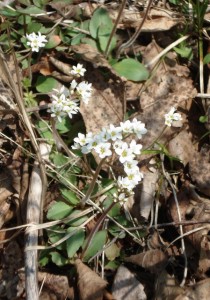 Early Saxifrage, Saxifraga virginiensis. Feel free to let me know if I’ve mis-identifed this one-I hadn’t brought the wildflower book with me on the hike, and have been identifying from pictures.
Early Saxifrage, Saxifraga virginiensis. Feel free to let me know if I’ve mis-identifed this one-I hadn’t brought the wildflower book with me on the hike, and have been identifying from pictures. 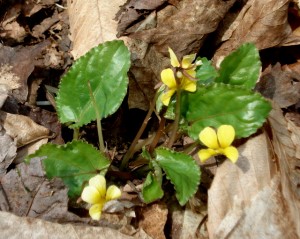 This was a great find, and a bear to identify. Round Leafed Yellow Violet, Viola rotundifolia. the only stemless yellow violet, with flowers and leaves on separate stalks.
This was a great find, and a bear to identify. Round Leafed Yellow Violet, Viola rotundifolia. the only stemless yellow violet, with flowers and leaves on separate stalks.

















You must be logged in to post a comment.